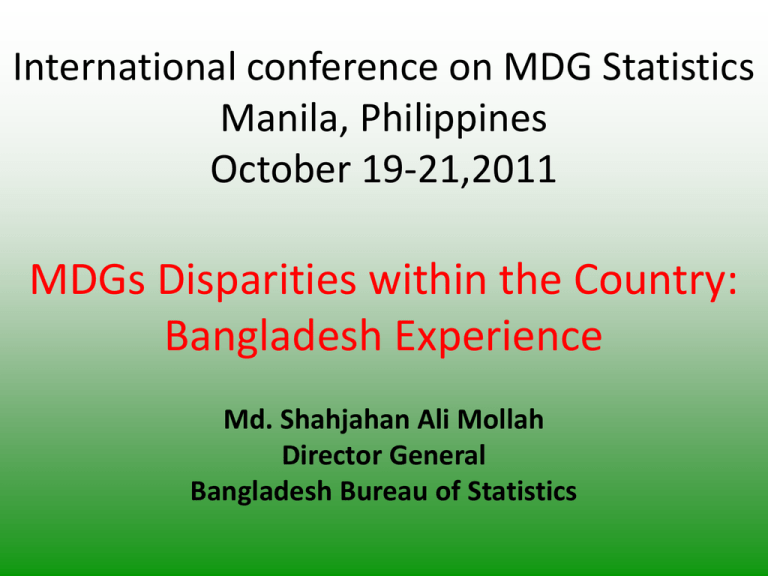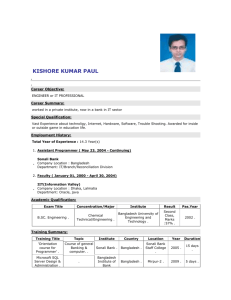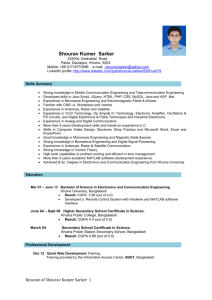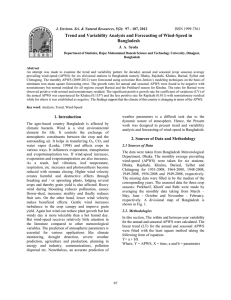MDG disparities within the country (Bangladesh)
advertisement

International conference on MDG Statistics Manila, Philippines October 19-21,2011 MDGs Disparities within the Country: Bangladesh Experience Md. Shahjahan Ali Mollah Director General Bangladesh Bureau of Statistics Sources of MDG Indicators in Bangladesh BBS Sources Besides conducting Population, Agriculture and Economic Censuses, BBS carries out four surveys, inter alia, to monitor the progress towards MDGs – Multiple Indicator Cluster Survey (once in every 3 years) – Sample Vital Registration System (round the year in each year) – Household Income and Expenditure Survey (round the year in every 5 years) – Labour Force Survey (once in every 5 years) Other Sources • • • • • • • Demographic and Health Survey (DHS) EPI overage Survey MIS System of Health Department Department of Environment Department of Forest Primary and Mass Education Division Administrative Records of Different line Ministries MDG -1:Regional Disparity Poverty Headcount Poverty Gap Squared Poverty Gap Barisal 39.4 9.7 3.4 Chittagong 26.2 5.1 1.5 Dhaka 30.5 6.2 1.8 Khulna 32.1 6.4 2.0 Rajshahi 35.7 8.0 2.5 Sylhet 28.1 4.7 1.3 Bangladesh 31.5 6.5 2.0 Division MDG Base year: 56.6 Target by 2015: 29.0 Base year:17.0 Target by 2015: 8.0 MDG-2 :Regional Disparity Net enrolment ratio in primary education (net attendance rate in primary school) Proportion of pupils starting grade 1 who reach last grade of primary education Barisal 84.7 81.2 Chittagong 78.4 80.2 Dhaka 82.5 79.9 Khulna 87.0 74.2 Rajshahi 81.3 81.4 Sylhet 74.2 80.6 Bangladesh 81.3 79.8 Division MDG Base year: 60.5 Base year: 40.7 Target by 2015 : 100 Target by 2015: 100 MDG-3 :Regional Disparity Ratios of girls to boys in primary education Ratios of girls to boys in secondary education Barisal 1.03 1.2 Chittagong 1.02 1.19 Dhaka 1.02 1.13 Khulna 1.03 1.2 Rajshahi 1.04 1.18 Sylhet 1.03 1.16 Bangladesh 1.03 1.17 Division MDG Base year : 0.83 Base year : 0.52 Target by 2015: 1.0 Target by 2015: 1.0 MDG-4:Regional Disparity Division Infant mortality rate U5 mortality rate per 1000 live births per 1000 live births Barisal 44 46 Chittagong 33 52 Dhaka 34 45 Khulna 39 41 Rajshahi 36 49 Sylhet 43 50 Bangladesh 36 47 MDG Base year : 92 Target by 2015: 31 Base year : 146 Target by 2015: 48 MDG-4:Regional Disparity Children of one year age vaccinated against measles Divisions Barisal Chittagong Dhaka Khulna Rajshahi Sylhet Percent of children immunized 90.4 86.6 85.5 92.8 90.8 79.9 MDG-5:Regional Disparity Division Maternal mortality ratio per 100000 live births Proportion of births attended by Skilled health personnel Barisal 250 15.0 Chittagong 247 20.8 Dhaka 207 28.2 Khulna 222 30.4 Rajshahi 182 24.4 Sylhet 285 14.4 Bangladesh 216 24.4 MDG Base year: 574 Base year: 5.0 Target by 2015: 144 Target by 2015: 50 MDG-5:Regional Disparity Mothers received ante-natal care more than once during pregnancy Division Barisal Chittagong Dhaka Khulna Rajshahi Sylhet Percentage 53.3 57.2 55.3 58.8 58.6 50.1 MDG-6:Regional Disparity Proportion of population aged 15-24 years Division (women) with comprehensive correct knowledge of HIV/AIDS Literacy rate of 15-24 yearolds (women) Barisal 14.4 76.1 Chittagong 12.6 72.4 Dhaka 16.0 71.9 Khulna 19.4 77.5 Rajshahi 13.4 70.0 Sylhet 9.4 64.1 Bangladesh 14.6 72.0 MDG Base year: NA Base year: NA Target by 2015: NA Target by 2015: NA MDG-7: Regional Disparity Proportion of population using an improved source of drinking water Proportion of population using an improved sanitation facility Barisal 96.6 67 Chittagong 97.2 59.1 Dhaka 99.6 51.3 Khulna 94.7 59.7 Rajshahi 99.2 49.1 Sylhet 91.6 49.7 Bangladesh 97.8 54.1 Division MDG Base year: 89.0 Base year: 21.0 Target by 2015: 100 Target by 2015: 60 Probable Reasons of Regional Disparity • Geographical setting of the country: coastal regions, hilly regions and flood prone areas • Unequal distribution of government resources and development interventions • Diversified cropping pattern • Lack of electricity and natural gas in some regions • Seasonal unemployment in some areas Steps Taken by Bangladesh in improving the MDG Monitoring System The current MDG monitoring system suffers from some limitations, particularly the nonavailability of disaggregated data and long interval of the national level surveys, Therefore , for improved monitoring system the following steps are being taken: The frequency of the current national level surveys will be increased Steps Taken by Bangladesh in Improving the MDG Monitoring System • The sample size of the existing surveys will be be enhanced to provide data at the sub national level to capture regional disparity • New surveys are being undertaken to meet the data gaps namely Health and Demographic Survey, Literacy Assessment Survey, Child and Mother Nutrition Survey etc. • Additional modules are being added to existing surveys to capture data of selected indicators relevant to the present survey Conclusions •Bangladesh is on right track of reducing poverty •The progress of health and education sectors is encouraging •Priority should be given to indictors which are lagging behind Thank You





